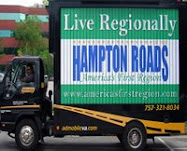
PURPOSE
To discuss the impacts of a worst case scenario in which an OLF to support Naval Air Station (NAS) Oceana is not located in Virginia or North Carolina.SUMMARY
The future of NAS Oceana – and to some extent Naval Station Norfolk - is strategically, operationally, and politically tied directly to finding an OLF that meets the Navy’s requirements. Should Navy decision makers not have the benefit of politically and operationally viable sites that meet their mission requirements, they could find themselves in a ‘checkmate’ situation, with no long range alternative other than to find a new east coast master jet base.Once this situation develops, the ability of the Virginia congressional delegation, the Commonwealth, and the Hampton Roads region to prevent the loss of an aircraft carrier to another homeport and the loss of other capabilities will be seriously hampered – if not fatally neutralized. This IS the worst case scenario.
BACKGROUND
An OLF to augment existing carrier landing practice capabilities at NAS Oceana and Naval Auxiliary Landing Field (NALF) Fentress is required to provide the operational robustness necessary to NAS Oceana’s ability to accomplish its mission.Strong, well-organized public opposition and the eventual political collapse of the Navy’s preferred OLF site (Site C) in Washington County, North Carolina, changed the dynamics of the OLF identification process, allowing the Commonwealth of Virginia to explore opportunities within the state. North Carolina officials began a parallel process and have offered alternative sites, but there is no indication that a solution exists in North Carolina. At least one of these sites is further south than Site C, extending the distance between the OLF and NAS Oceana which makes it less operationally suitable.
The Navy must soon make a decision regarding the OLF situation. That decision will be based on the results of the alternative site identification processes conducted by Virginia and North Carolina, and the existing environmental impact statement (EIS) that resulted in the earlier selection of Site C. There is a chance that the Navy may re-evaluate the original OLF sites in North Carolina should viable alternatives not be found in Virginia or North Carolina, however there is a low likelihood of this possibility. A Herculean effort would be required to pursue this course of action.
DISCUSSION
For the Commonwealth of Virginia the worst case scenario is a failure to identify any politically suitable, operationally viable OLF sites in Virginia or in North Carolina, thereby providing an incentive to the Navy to move aircraft to other locations. In this worst case scenario, the Navy will be driven by necessity to seriously examine the future viability of NAS Oceana as the east coast master jet base if it cannot meet mission requirements. This opens the door to political suitors to invigorate their efforts to attract the Navy away from NAS Oceana (NAS Kingsville, TX; NAS Pensacola, FL; Moody Air Force Base, Valdosta, GA; etc.) and establish a new east coast master jet base.Further, there is an undisputed relationship between carrier aircraft basing and aircraft carrier homeporting; proximity is preferred.
The following considerations are germane:
- While the cost of constructing a new master jet base from scratch with an adequate OLF nearby is on the order of $1.8 billion, the relocation to an existing base – particularly one with a welcoming political and public environment – is less expensive. State or local incentives could make such a move even more attractive to the Navy.
- While Fleet Forces Command (FFC) has stated that the immediate challenge is an OLF to support NAS Oceana, it is not unreasonable to believe that a more strategic, longer-term view has long considered the idea of establishing a new master jet base to replace NAS Oceana.
- The newly nominated FFC Commander, Vice Admiral Greenert – assuming he is confirmed – will be the most junior four star in the Navy. He is a submariner whose operational experience is all with the Pacific Fleet and he has no prior affiliation with Hampton Roads.
- The current Commander Navy Region Mid-Atlantic, Rear Admiral Ruehe retires in October. He is being relieved by Rear Admiral Mark S. Boensel, the current Commander Navy Region Southeast – in whose region many of the potential suitor sites for locating a master jet base exist.
- The EIS for Joint Strike Fighter (JSF) is likely very problematic for NAS Oceana given current noise and other issues surrounding NAS Oceana. As the Navy integrates JSF into the force it will need to find more suitable operating bases out of necessity.
- A second law suit seeking $500 million in damages has just been filed regarding the noise at NAS Oceana; earlier this year the Department of Justice settled a similar law suit for $38 million, setting a potential precedent for the success of a new suit. It is questionable whether or not the settlement of the first suit would support the later basing of JSF at Oceana by precluding a subsequent suit.
- While Virginia and Hampton Roads are represented on both the Senate and House Committees on Armed Services, and they have thus far been aggressive and effective in protecting existing capabilities, potential opponents both outnumber and outrank our congressional delegation. Further, Hampton Roads is not represented on either the Senate or House Committees on Appropriations. Thus, the Virginia congressional delegation’s ability to continue to protect existing capabilities and advocate for new ones becomes more problematic.
CONCLUSION
Failure to find an operationally viable OLF site in Virginia is the seminal point in characterizing the Navy’s future footprint – and economic and cultural impact of that presence – in the Commonwealth of Virginia and the Hampton Roads region. Without an OLF supporting NAS Oceana, the Navy will be pressured to put NAS Oceana on the next Defense Base Closure and Realignment (BRAC) list or initiate movement of aircraft to other locations, likely to be accompanied by the relocation of an aircraft carrier. The result will be a dramatically changed military landscape in Hampton Roads in the next 5 to 10 years.Author: Frank Roberts, Executive Director of the Hampton Roads Military and Federal Facilities Alliance (HRMFFA) whose mission is to proactively protect, preserve and grow military and federal capabilities in Hampton Roads for the common good and welfare of the residents of the Hampton Roads. Through regional advocacy and influence the Alliance acts to retain and attract organizations, capabilities, and investments owned, operated or funded by the Federal government.
NOTE: The original date of this paper is Oct 2007. RADM Boensel has been Navy Mid-Atlantic Commander since Nov 2007. VADM Greenert has been Commander of U.S. Fleet Forces Command since Sep 2007 and is off to become the new Vice Chief of Naval Operations (VCNO), the second highest ranking officer in the United States Navy, this summer.































No comments:
Post a Comment